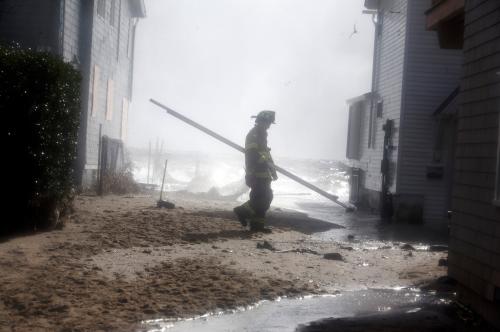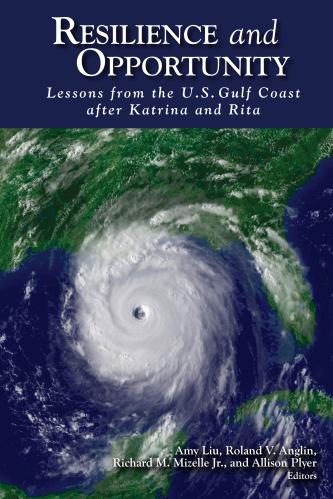Even as the Gulf Coast states battle to recover from Hurricane Katrina, Washington should take heed of the chaos surrounding the early relief effort. If this is what happens when the nation has two days of advance warning, imagine the aftermath of a surprise attack using a chemical, biological or nuclear device.
There will be plenty of stories of heroism in coming months as thousands of volunteers descend on the disaster zone. But the hubris is already showing. Thousands of residents ignored the evacuation warnings; many relief agencies waited until the hurricane had passed to start sending supplies and volunteers to jumping-off points in surrounding states; and the president was heading to California as the hurricane moved in. Although the Department of Homeland Security and its Federal Emergency Management Agency are moving at near-light speed to coordinate an unprecedented relief effort built around DHS’s National Response Plan, the nation must get even faster in the future.
Ironically, a Category 5 hurricane was already on the Department of Homeland Security’s list of 15 planning scenarios for emergency response. In an effort to give organizations more specific guidance about how to plan for catastrophic events, the department issued the scenarios last winter in the hopes that governments, businesses and charitable organizations would start rehearsing their response.
Unfortunately, a yet-to-be-released survey by New York University suggests that most Americans expect disaster to hit just about anywhere but home. Most have enough canned goods and bottled water in the closet to last a few days, but they want their local police and fire agencies, the Red Cross, and charities to tell them what to do in the event of a catastrophe. The problem with Katrina is that many citizens did not listen before the hurricane, and communications were cut off after. Plenty of emergency planners had nightmares about a Category 5 hurricane hitting somewhere, but few woke up and started preparing.
Katrina underscores the urgent need to build a robust national preparedness and response system that can bend and flex to the unique circumstances of natural or human-caused catastrophes. Based on my analysis of hundreds of high-performing organizations identified by the nonpartisan Rand Corp., such a system must be alert to impending catastrophe, agile in implementing well-designed plans for response and recovery, adaptive to surprise events such as the collapse of the New Orleans levees, and aligned so that everyone can pull together, from Washington on down to the initial first-responder who shows up at the site of a disaster.
Here are the four pillars of a robust response system:
-
- Alertness to what lies ahead. As Katrina surely suggests, the nation faces many possible catastrophes, some that can be predicted, others unexpected but inevitable. A high-performing response system is constantly scanning a wide range of scenarios while establishing signposts that will trigger the kind of action that would have saved precious time after Katrina had moved on. Katrina gave fair warning, but no terrorist will.
- Agility in recruiting, training, retaining and redeploying a talented, flexible workforce. Too many local governments have yet to complete even the most basic training on how to respond to a small-scale catastrophe such as a terrorist bombing at a local shopping center, let alone an attack on a chemical refinery. Even when governments, businesses, and charitable organizations think ahead, they rarely do so together, creating a sum less than the parts when catastrophe strikes.Agility also involves making sure first responders can talk to each other on equipment that can survive a major catastrophe.
- Adaptability. Although no one can be prepared for every eventuality, a robust system provides enough flexibility in dollars, equipment and 3,000-pound sandbags to bring innovation to bear on unexpected events such as flooding and massive fatalities. Unfortunately, Congress, the president and many governments have been doing homeland security on the cheap or through pork-barrel spending.
- Alignment of all organizations to a central plan. As New Orleans Mayor Ray Nagin complained the day after his levees collapsed, there are “way too many fricking . . . cooks in the kitchen.” Having an aligned system means just one cook in the kitchen and hundreds of servers on the front lines. If aligning a system means that governments, businesses and charitable organizations have to cede authority to a single director, so be it. Catastrophe is no time for protecting bureaucratic turf.
Creating this kind of robust response system requires time, money, constant rehearsal and concentration. And it requires individual organizations that are robust, too. This is why Homeland Security Secretary Michael Chertoff’s recently proposed reorganization is so important to implement. By eliminating needless layers of management and focusing on the most likely scenarios, Chertoff is taking an essential step toward creating a more robust department, which in turn will help create a more robust response system.
If Congress really wants to prepare for future disasters like Katrina, it will attach Chertoff’s reforms to whatever relief legislation it is sure to pass in coming weeks. At least in planning for catastrophe, preparedness starts at the top, not the bottom, with clear signals about where to invest, whom to engage and how to coordinate.









Commentary
Op-edKatrina’s Lesson in Readiness
September 1, 2005